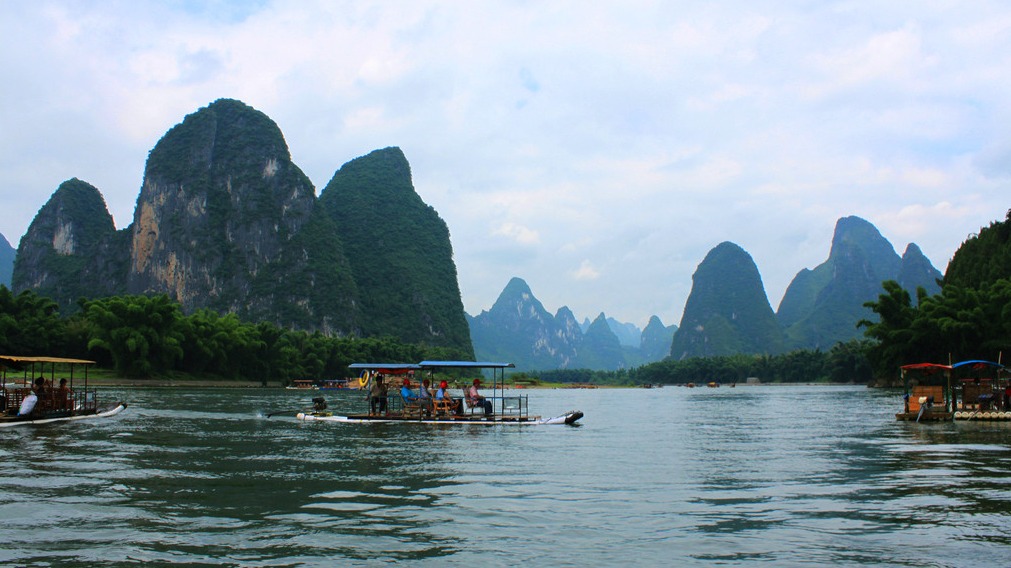Situated in the northeast of the Guangxi Zhuang Autonomous Region, Guilin has long been renowned for its unique scenery of karst topography and time-honored history and culture. It is a world-renowned city for sightseeing, an international tourism city and a famous historical and cultural city in China. As the most popular tourist destination, it is dubbed as the “Unparalleled Landscape under Heaven”.
As a world-famous scenic city, Guilin boasts unique scenery of karst topography. The mountains are steep and varied in shapes with numerous secluded caves; the water in Li River twists and turns, shining as bright as a mirror. The most typical attractions include Elephant Trunk Hill, Fubo Mount, South Stream Hill, Mount Yao, Solitary Beauty Peak, Seven Star Crags, Reed Flute Crags, Zengpi Crags, Crwon Crags, King’s City of Ming Dynasty, Jingjiang Mausoleum, Banyan Lake, Cedar Lake and Wooden Dragon Lake. Other beautiful sceneries in different counties and districts of Guilin include Terraced Fields, Xing’an Lingqu Canal, Maoer Mount, Zi River Rafting, Wupai River Rafting, Bajiao Stockade, Baoding Waterfall, which will bring you a lot of fun.
There is a beautiful folklore about the mountains and rivers in Guilin. Legend has it that when seven fairies from heaven accompanied each other and descended to earth to appreciate the secular beautiful sceneries, the youngest one pitied the sufferings of the people caused by floods, so she rode in private the Heavenly Elephant, or the ride of Jade Emperor, to the mortal world to help people dredge rivers. Shortly afterwards, the Jade Emperor became aware of this, sent a heavenly general to take the youngest fairy back, turned the Heavenly Elephant into a rock mountain and quelled it with a treasured sword, never to return to heaven as punishment. One day, as Samantabhadra Bodhisattva traveled to this place, he was moved by the Heavenly Elephant’s virtue and used his supernatural power to pull the sword out of the Elephant and instead placed his divine vase on the back of the Elephant because after all, it violated the heavenly rules by descending to earth in private. Later, the divine vase became the Samantabhadra Pagoda. After a long time, the same Bodhisattva rode a white elephant and traveled back to this place. He wanted to have another try to take the Elephant back to heaven, only to find that it had already been transformed into a hill. When he set out to fly back to heaven, he found no single person or livestock along the river because the river turned too dirty to think. After careful observation, he discovered that due to the lack of rocks underneath the river, the soil in the river cannot be deposited. As a result, the Bodhisattva turned its while elephant into a glittering “roch feet” in the Li River. In a moment, the “rock feet” was changed into numerous glittering rocks, clearing the Li River in no time. Therefore the people began to settle down alongside the river. The people afterwards named the Heavenly Elephant-turned hill as Elephant Trunk Hill in honor of what it has done for the people. Also, in memory of the kindheartedness of the Bodhisattva and the sacrifices of the while elephant, the people named the rocks in the Li River as Clearing Water Rock. The people in Guilin have a penchant for Elephant Trunk Hill and Li River Clearing Water Rock. The culture of rock and landscape appreciation has become an integral part of their daily lives. People collect jade and stones and put them everywhere, in their houses, in the courtyard, in the halls and on themselves. As the saying goes, if there are rocks, mountains will be queer, waters clean, houses peaceful, gardens seclusive, halls elegant and one’s bodies noble. There is another folklore, saying that actually, the rocks are the right foot of Samantabhadra Bodhisattva who stepped on golden lotus to improve the wellbeing of the people. Therefore, it is believed that the Clearing Water stones would be able to ward off evil spirits, protect the house and help people to get rich and lucky.
With nationwide reputation, Guilin’s cuisine boasts unique local flavor, combining sour and spicy flavor of Hunan cuisine with light Cantonese cuisine. The homemade dishes have been influenced heavily by Hunan cuisine, so have the restaurants. As the tourism sector continues to grow, there are increasingly more varieties of cuisines, including Huaiyang, Minnan, Chaozhou, Northwestern China, and Guangxi cuisines. Some fashion restaurants are sprouting, such as western cuisines and Chinese fast food that are very popular among the youth. Among the varieties of cuisines, Guilin rice noodle is the most famous. It has exquisite making process. Firstly, grind high quality rice into syrup, filter it in bags, knead it rice dough, cook it and squeeze it into noodles. If it is round, it is called rice noodle; if in pieces, it is called sliced rice noodle. The characteristics of Guilin rice noodles are while, tender, soft and tasteful. There are a number of ways to eat it. The key ingredient is brine that is usually made of swine and ox bones, Momordica grosvenori and different seasonings. With different brine comes with different tastes of rich noodles, like lettuce, brisket, three delicacies, raw soup, pot-stewed meat, sour ans spicy, horse meat and cold sauce, to name but a few.
With its picturesque landscape and time-honored history and culture, Guilin will be able to increase its city influence and build itself into a world-class landscape and cultural tourism resort.
